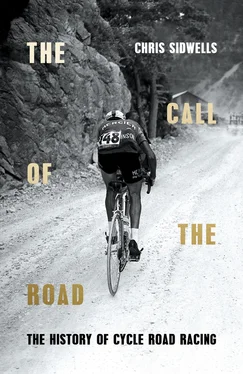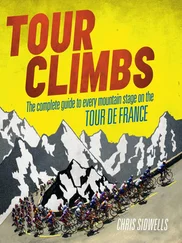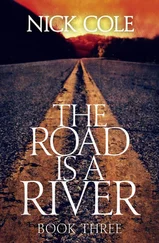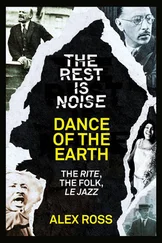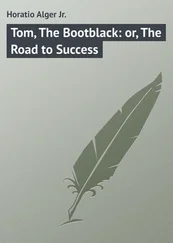A few days later Mills started another ‘End to End’, as the Land’s End to John O’Groats record was already being called. This time he rode a tricycle, a three-wheeled version of the safety bicycle, which some long-distance road racers preferred because of its stability. Mills set a new tricycle record of 5 days and 10 hours, but he still wasn’t done for the year. In September 1886, along with his partner A. J. Wilson, Mills broke the British tandem tricycle records for 50 and 100 miles. Then on 5 October Mills switched to a safety bicycle and set a new 24-hour figure of 295 miles. Six long-distance records in one year must be a record in itself.
But as time went on, although he continued setting records, Mills was getting pushed hard by a club-mate. His name was Montague Holbein, and he broke a number of Mills’s records as well as setting new ones of his own. That’s why Mills and Holbein, along with Selwyn Edge and J. E. Bates, who were all from the same North Road Cycling Club, were invited to take part in the first ever Bordeaux–Paris race by its organisers, a newspaper called Le Véloce Sport .
When the British riders were invited, Bordeaux–Paris was scheduled to be a professional race, but Mills and the other Brits were amateurs. So the National Cycling Union (NCU), which like so many early British sporting bodies didn’t approve of professionalism, asked the French organisers to change the race’s status and only allow amateurs to enter.
They did, and the first ever Bordeaux–Paris, held on 24 May 1891, was a race for amateurs only. The 38 entrants started at 5 a.m. from the Pont Bastide in Bordeaux. As well as four British riders, there was one Swiss, one Pole, and the rest were French. All rode safety bicycles apart from one French amateur entrant, Pierre Rousset, who preferred a tricycle – as befitted his age perhaps? He was 56.
The betting put Mills and Holbein as 2:1 favourites. Holbein had recently set a new British 24-hour bicycle record of 340 miles, and a 12-hour record of 174 miles. Those figures impressed the bookies, who’d obviously done their homework. To ensure everybody covered the same course, and that they covered it entirely by bicycle, or tricycle in Rousset’s case, each competitor was given a booklet with fourteen towns and villages in it. The booklet had to be signed by race officials and stamped at controls in each of the fourteen designated towns and villages, otherwise the rider would be disqualified. Gold medals and objets d’art were offered for the first ten to arrive in Paris. Silver medals and a palm branch were given to each of the next finishers, so long as they arrived within three days of starting. Bronze medals were awarded to finishers inside four days, and there were diplomas for those who were inside five days.
Race day dawned dark and foggy. Rain had fallen for several days, there were very few spectators early on, but a big crowd awaited the riders at Angoulême, where the four Brits arrived together at 10.30 a.m. They had a good lead, and stopped for five minutes. They ate soup, replenished the stores of food they carried with them, had their control books stamped and signed by officials, then remounted and rode off into the grey gloom.
A Frenchman, Henri Coulliboeuf, was next to arrive at 10.55 a.m., then Joseph Jiel-Laval at 11 a.m. He was half an hour ahead of the next rider, and the tricyclist Rousset rolled into Angoulême around 1.45 that afternoon.
Pacers were allowed to join the race at Angoulême, and after meeting his first one, who was called Lewis Stroud, Mills tucked in behind him and drew away from his compatriots. By the time he reached Châtellerault, Mills led by half an hour from Holbein, then Edge, and then Bates. And so it went on, Mills drawing inexorably further ahead as pacemaker after pacemaker relayed him towards Paris. Mills passed the finishing post in Paris 26 hours and 36 minutes after he’d set off from Bordeaux. The total distance ridden was 356 miles.
It was a very professional and disciplined display by the British amateur. As well as having fast pacers, Mills spent minimal time when he stopped at controls, just taking morsels of food. He carried anything else he needed with him. The race was big news in Britain, and several British newspapers followed it, placing journalists at various points along the route. At Tours the Birmingham Daily Post correspondent noted that ‘Mills swallowed a dog-mouthful of finely-chopped meat and drank a bottle of specially-prepared stimulant.’
British riders took the first four places in that first Bordeaux–Paris. Holbein was second in a time of 27 hours and 52 minutes, Edge was third in 30 hours and 10 minutes, and Bates was fourth, just 8 seconds behind him. The first French rider, Jiel-Laval, was fifth, nearly two hours behind Bates. And the stately Rousset? He finished 15th on his tricycle in 63 hours and 29 minutes.
The race was a great success, and Bordeaux–Paris soon became a professional race and a fixture in the pro calendar. For a while it was considered one of road racing’s classics, especially from 1945 onwards, when the competitors were paced for the last two-thirds of the race by men riding small motorbikes called Dernys, after their inventor Roger Derny. Pacing was preserved in Bordeaux–Paris long after similar marathon bike races died, because it meant they covered the distance in a reasonable time, but the race required specific and dedicated training which, as the sport developed, fewer riders were prepared to do each year. The last Bordeaux–Paris was in 1988.
Le Véloce Sport achieved a coup by staging Bordeaux–Paris, which was irksome to Pierre Giffard, the editor of Le Petit Journal . So in response he came up with something absolutely staggering, something he hoped would make Le Véloce Sport ’s piddling little 572-kilometre race pale into insignificance, and for a while it did. Paris–Brest–Paris was the longest road race in the world. The trip from Paris to Brest, near the tip of the Breton peninsula, and back to Paris is close to 1,200 kilometre and, like Bordeaux–Paris, it was done all in one go. Riders could rest, sleep, sit down to eat, do what they liked, but the clock kept ticking, and any non-riding time was included in their finishing time.
Giffard called his race an épreuve , a French word that can mean test, trial or ordeal. He chose the word because he saw the race primarily as a test of bikes, something designed to show the durability and capability of what was still a fairly new invention. The founding rule of Paris–Brest–Paris was that competitors must complete the course on the same bike, which had to be delivered to the organisers before the start. Identifying seals were placed on each bike and on its parts, and the bikes were kept in parc fermé conditions until the start. That doesn’t happen in cycling any more, but the French stuck with épreuve as a word to describe bike races. It helps convey the sense of bike races being tests of man or woman and machine.
When news of Paris–Brest–Paris got out, entries came from abroad and from a few women, but they were all refused. So, on 6 September 1891, a group of 207 Frenchmen set out from Paris and headed for Brest. There were ten riding tricycles, four on two tandems, and one die-hard listed as Monsieur Duval who was riding a penny-farthing. The other 192 competitors raced on safety bicycles. Amateurs and professionals were mixed together, but the pros were allowed up to ten pacers each to meet them at different points along the way. The pacers carried extra food and drinks for their riders. Racers weren’t allowed to swap bikes with anybody, but they could make repairs, so long as they did them without help.
Charles Terront raced without sleep for 71 hours and 22 minutes to win the first Paris–Brest–Paris by almost eight hours. Ninety-eight riders battled through to finish behind him. Some competitors took days longer than Terront, stopping at inns and hotels overnight. It was a huge success, though, and the race captured the imagination of people who lined the route and followed the riders’ progress through newspaper dispatches and reports.
Читать дальше
